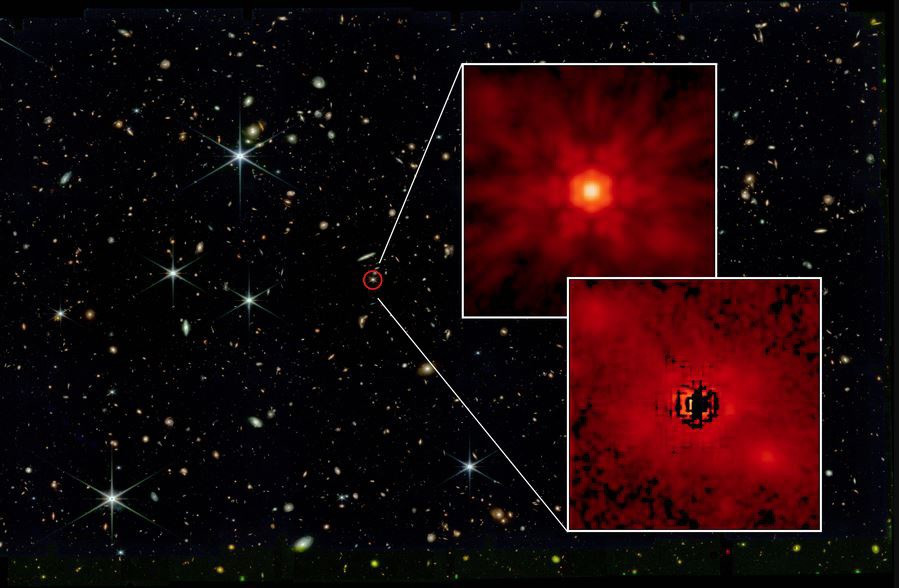Io, the most volcanic planet in the solar system, continues to surprise us. NASA's Juno spacecraft flew by the innermost Galilean satellite on February 3, 2024. This PJ58 flyby (Piregov 58The ship was allowed to pass a distance very similar to that which took place on December 30, that is, about 1,500 kilometers. As with the PJ57, the images are stunning. For some areas, Juno has the highest resolution images since Voyager 1 passed by this moon in 1979. The images correspond to a hemisphere of Io dominated by volcanic craters, paterae With its Latin name according to the naming conventions of the International Astronomical Union. Among all the calderas, the famous Loki Patera, the largest lava lake in the solar system, undoubtedly stands out. In addition, the angle of the Sun relative to the probe left us with a unique image. Look closely at what Loki Patera looks like in the following image, left:
In fact, the sun's reflection can be seen on the surface of the caldera, a characteristic due to its solid nature. To better understand the above image, look at this other image taken by Voyager 1 in which Loki Patera stands out as a large black lake:

This other image processed by Björn Jónsson compares views of Loki Patera during Juno's last two voyages. In the photo on the left, taken in December, Loki Patera appears in its distinctive black color, while on the right you can see the change in color due to reflected sunlight (the horseshoe-shaped structure on the right is Loki the volcano itself).

Loki Patera – located at 13°N, 309°W – is the largest caldera on this small, turbulent moon. Next to it is the volcano Loki, which is the largest on Io, in terms of size and energy emitted. Loki Patera is a caldera so large that if you were on the surface – and assuming you could miraculously survive the lethal doses of radiation flooding this world – you wouldn't be able to see the other end because it would be beyond the world. Horizon due to the curvature of the moon. Loki Patera has an area of 21,500 square kilometers and a diameter of 203 km. The region's thermal emissions are greater than those of the remaining approximately 270 active volcanoes on Io combined (between 9 and 14 TW).


Although powerful, Loki, like the other volcanoes on Io, is not particularly tall. The magma on Io contains very little silica, so its viscosity is very low, even compared to the liquid lava of volcanoes like Kilauea in Hawaii. This explains why Io's eruptions look like huge geysers emerging from the ground through fissures, but there are no large volcanic edifices (although shield-type volcanoes do exist). Io's lavas also differ from those on Earth because of their very high sulfur content, which is the “engine” of these eruptions as sulfur gas expands as the magma approaches the surface void. Sulfur from volcanic eruptions is deposited as ice all over the moon's surface and is responsible for the yellow and red colors that give Io its “space pizza” appearance (hot sulfur compounds are very dark and when they cool, they become red, yellow, and finally, almost white).

Loki Patera has a black color due to basalt lava (the sulfurous “snow” that is deposited in the cauldrons simply evaporates). In its center there is an “island” and “icebergs” that have not moved in the past five decades, so it is believed that instead of floating in basalt lava, they are fixed structures. For this reason, it could be Loki Patera Renewed dome. Loki Patera's solid crust occasionally sinks, exposing new lava, a process that sometimes extends to the entire lake. “Renewal” of lava can last about 500 days. Undoubtedly, it must be a sight worth seeing up close. But, returning to the photo with which we opened this entry, if we look closely we can see the reflection of sunlight not only in Loki Patera, but also in Sêd Patera, Mazda Paterae or Gibil Patera, among others. It reminds me of the specular reflections of lakes on Titan, although in this case they were clumps of liquid methane. On the other hand, since it could not be otherwise, Juno has found some active volcanoes, this time in the Masubi volcano area.

After giving us these stunning images, Juno will no longer be close to Io. A shame, but at the same time a reminder of the urgent need to send a probe into this amazing world to reveal its secrets to us.
Night Revolution on IO!!!
Reviewing nighttime images of Pj58, I noticed a very prominent but faint plume on the night side of Io. This eruption will come from somewhere between the Kanihekili and Masubi eruption centers.@volcanopele pic.twitter.com/DDYVyh9RFD
– Alan Mir (@alanmir) February 6, 2024

“Beer enthusiast. Subtly charming alcohol junkie. Wannabe internet buff. Typical pop culture lover.”

:quality(85)/cloudfront-us-east-1.images.arcpublishing.com/infobae/7LFLBSHU4FG4FJIYGXW2IUHTDM.jpg)
:quality(85)/cloudfront-us-east-1.images.arcpublishing.com/infobae/7H35DR4K5BDFDMQV5GYX4MUDEA.jpg)

:quality(85)/cloudfront-us-east-1.images.arcpublishing.com/infobae/DYNT4CH2PNFCDKYIR4QDOERVD4.jpg)


More Stories
They noticed the elusive starlight surrounding ancient quasars
The first launch of the Starliner ship arrives with astronauts on board
A wonderful trip to the prestigious Xerox PARC laboratory